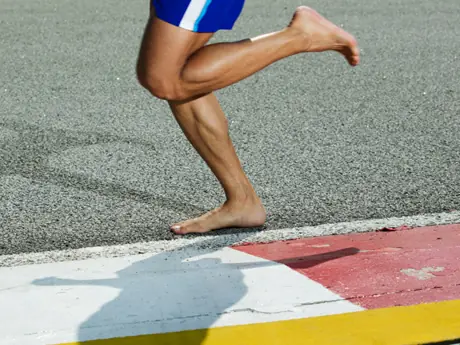
If I were to tell you that you could improve your 5K PR by 30 seconds if you ditched your clothes and ran naked at your next race, would you try it? What if I had absolutely no evidence to back up this claim other than a book I'd read about a tribe of Indians who were really fast and never wore racing singlets or running shorts because they couldn't afford them?
Would you do it? Does this sound reasonable to you?
Me neither. But you might have been one of the thousands of runners who decided to swear off traditional trainers and complete every run in barefoot-inspired shoes, and that's just as ridiculous as racing naked because you heard it might make you faster. Here's why:
More: What Can Kenyans Teach Us About Running?
* You're not a Tarahumara runner, the Mexican tribe who runs in homemade flimsy sandals out of necessity (maybe you are, but not likely).
* You've been wearing shoes, likely with cushioned soles, your whole life.
* Minimalist shoes won't make you faster.
* Barefoot-inspired shoes won't prevent injuries.
* These shoes are yet another way for retailers to take your money.
Don't believe me? Someone out there does.
Vibram's Lawsuit
In May 2014, a class action lawsuit was filed against the barefoot shoemaker Vibram. The lawsuit states that the popular FiveFingers shoes falsely claims that minimalist shoes strengthen the feet and prevent injuries to the lower extremities. The court didn't get to hear the evidence from either side because Vibram settled outside of court for 3.5 million dollars.
And the plaintiff wasn't alone in his claims.
The position the American Podiatric Medicine Association has officially taken is that the current research on the long-term effects of barefoot running is inconclusive. "Barefoot running has been touted as improving strength and balance, while promoting a more natural running style. However, risks of barefoot running include a lack of protection, which may lead to injuries such as puncture wounds, and increased stress on the lower extremities," the association states on its website.
The 2014 annual meeting of the American College of Sports Medicine reported similar sentiments. In the conference, five different studies were presented, with each finding no significant benefits on running economy by switching to minimalist style-footwear.
In fact, as reported by The New York Times, when a group of 566 runners was asked who had experimented with minimalist footwear and been injured, nearly one-third of them answered affirmatively. Minimalist running has been promoted as a way to fix a majority of the overuse injuries associated with running when, in actuality, if used in everyday training, it can do the opposite.
- 1
- of
- 3
About the Author
Get ACTIVE on the Go


Couch to 5K®
The best way to get new runners off the couch and across the finish line of their first 5K.
Available for iOS | Android






Discuss This Article